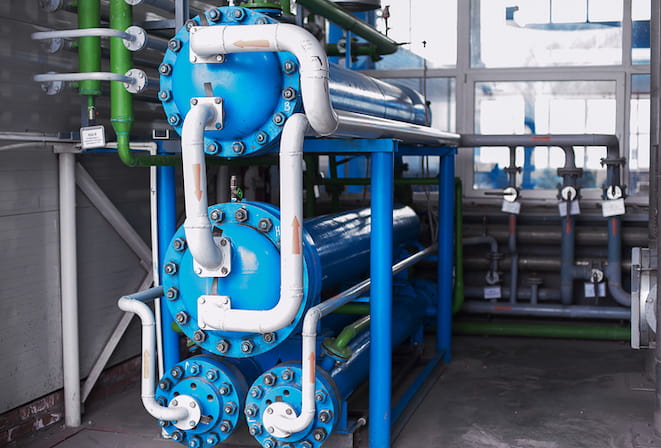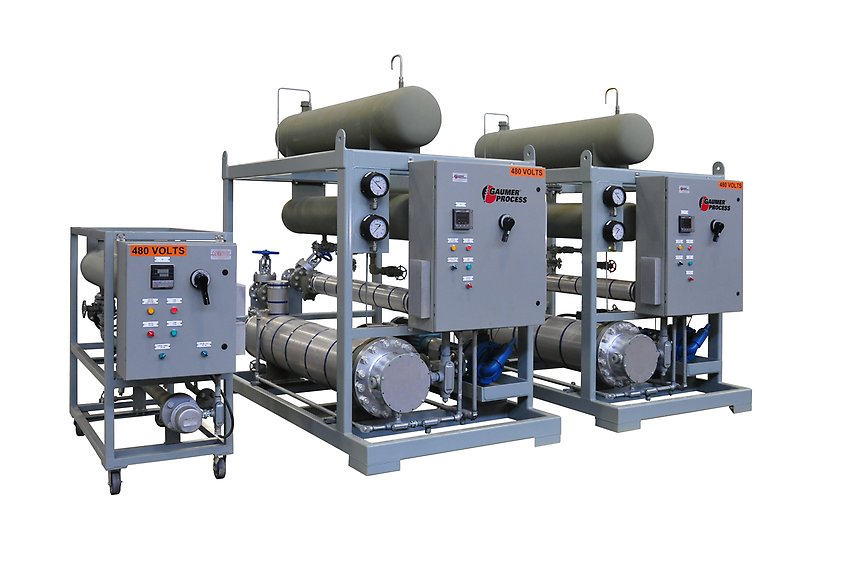Real-Time Monitoring: How DVS Heat Transfer Systems Enable Predictive Maintenance
The Function of Heat Transfer Solutions in Sustainable Energy Solutions for the Future
Heat transfer systems are essential in the mission for sustainable energy services. They enhance thermal energy monitoring, enhancing the performance of renewable technologies. By using systems like convection, transmission, and radiation, these systems reduce power losses. Their function in solar thermal and geothermal applications is particularly substantial. As developments emerge, the capacity for further developments raises important inquiries concerning future power methods. What developments will shape the landscape of lasting energy?
Understanding Heat Transfer Systems

The Significance of Thermal Power Management
Effective thermal energy monitoring is important for maximizing power effectiveness and reducing waste in various systems. By managing temperature and maximizing Heat transfer processes, companies can significantly lower energy usage and operational expenses. Reliable management involves the application of innovative technologies and methods that keep track of and control thermal conditions within systems, ensuring that power resources are utilized successfully. In enhancement, appropriate thermal power administration adds to reducing greenhouse gas emissions, straightening with global sustainability goals. It additionally improves system dependability and efficiency, causing boosted product top quality and longer tools life expectancy. Ultimately, prioritizing thermal energy monitoring is an essential action towards developing more sustainable power options and fostering an accountable technique to power intake in residential and commercial contexts.
Applications of Heat Transfer in Renewable Resource
While numerous renewable energy sources guarantee sustainability, the reliable application of Heat transfer plays a vital duty in their performance. In wind power systems, Heat transfer is used for turbine part air conditioning, enhancing performance and durability. Geothermal power relies upon efficient Heat exchange in between the earth's subsurface and the liquid flowing in the system, making the most of power extraction. Biomass power procedures likewise gain from Heat transfer, as it aids in transforming natural products right into useful fuel via pyrolysis and gasification. Additionally, in hydropower, maintaining excellent temperatures in reservoirs can boost energy output. Each of these applications shows the vital significance of Heat transfer systems in enhancing eco-friendly power technologies, ultimately adding to a more sustainable energy future.
Enhancing Solar Thermal Power Efficiency
As solar thermal power systems remain to evolve, enhancing their efficiency has actually ended up being essential for maximizing power result. Breakthroughs in Heat transfer innovations, such as boosted thermal storage products and cutting-edge Heat exchangers, play a substantial role in improving efficiency. By using sophisticated products that have premium thermal conductivity, systems can catch and move Heat more efficiently. Additionally, incorporating tracking systems that comply with the sun's course warranties that collection agencies receive ideal solar exposure throughout the day. Utilizing nanotechnology in solar absorbers can further boost energy absorption prices. Including computerized control systems assists control temperatures and handle power circulation efficiently, leading to lowered losses and enhanced overall system performance. These enhancements pave the way for even more sustainable solar thermal power remedies in the future.
Geothermal Heating: A Sustainable Remedy
Geothermal home heating provides a viable choice for lasting energy, offering considerable environmental advantages with minimized greenhouse gas emissions. Its performance and cost-effectiveness make it an eye-catching alternative to standard heating unit. Difficulties associated to application needs to be addressed to optimize its prospective impact.
Environmental Advantages of Geothermal
Conventional home heating methods contribute substantially to greenhouse gas exhausts, geothermal heating presents an engaging alternative that lessens environmental influence. By utilizing the Planet's interior Heat, geothermal systems use an eco-friendly energy source, markedly lowering dependence on nonrenewable fuel sources. This approach produces marginal carbon discharges, making it a cleaner option for commercial and property heating. In addition, geothermal systems advertise power efficiency, as they require much less power compared to traditional heater. DVS Heat Transfer Systems. The usage of geothermal energy likewise assists in reducing air contamination, boosting neighborhood air high quality and public health and wellness. As a lasting service, geothermal heating supports climate modification mitigation efforts, placing itself as a crucial component in the shift towards a greener future
Performance and Cost-Effectiveness
Just how does geothermal home heating gauge up in terms of efficiency and cost-effectiveness contrasted to conventional heating unit? Geothermal heating demonstrates superior effectiveness, typically attaining a coefficient of performance (POLICE) of 3 to 5, meaning it creates 3 to five units of Heat for every unit of power eaten. This efficiency equates into reduced operating prices, specifically in areas with secure geothermal resources. Preliminary installment expenses can be greater than standard systems; nevertheless, long-lasting financial savings on power expenses and minimized upkeep expenditures can offset these upfront investments. Furthermore, several federal governments incentivize geothermal systems through discounts and tax obligation credit scores, improving their cost-effectiveness. In general, geothermal home heating emerges as a sustainable and financially feasible choice to more conventional heating remedies.
Implementation Obstacles and Solutions
Countless obstacles can hinder the extensive execution of geothermal home heating systems, pop over to these guys regardless of their clear advantages as a lasting power solution. High first installment expenses usually deter property owners and financiers, making funding a significant barrier. Furthermore, the geographical constraints of appropriate geothermal websites restrict access in certain regions. Neighborhood guidelines and permitting procedures can likewise make complex task advancement, resulting in delays. Public recognition and understanding of geothermal systems remain reduced, impeding acceptance. To address these challenges, targeted education campaigns can enhance public expertise, while government motivations could alleviate financial problems. Teaming up with regional authorities to simplify policies might assist in smoother project approvals, eventually advertising the adoption of geothermal heating as a sensible, lasting energy alternative.
Developments in Heat Transfer Technologies
Developments in Heat transfer innovations play a crucial function in enhancing power performance and sustainability. Advanced Heat exchangers and stage modification products go to the center of these developments, supplying substantial enhancements in thermal monitoring. These innovations not just maximize power usage however likewise add to reducing ecological influence in various applications.
Advanced Heat Exchangers
Advanced Heat exchangers play a vital function in boosting energy effectiveness throughout various applications in lasting power solutions. These gadgets promote the transfer of Heat between two or even more fluids, considerably minimizing power consumption in processes such as commercial home heating, cooling, and power generation. Advancements in products and design, such as the use of nanofluids and small setups, have actually led to enhanced thermal performance and decreased size demands. Furthermore, improvements in digital surveillance and control systems permit maximized procedure, more raising efficiency. By reducing waste Heat and optimizing power his comment is here recuperation, advanced Heat exchangers contribute to decrease carbon footprints and support the shift towards eco pleasant modern technologies. Their continued development is important for attaining global power sustainability objectives.
Phase Modification Products
The assimilation of stage adjustment materials (PCMs) into Heat transfer technologies stands for a significant advancement in power management and performance. PCMs soak up and launch thermal energy during their phase changes, making it possible for reliable temperature policy in building products and energy systems. By keeping excess Heat throughout top durations and launching it when demand increases, PCMs add to load changing and power conservation - DVS Heat Transfer Systems. This ability improves the performance of sustainable power systems, specifically in solar thermal applications. In addition, PCMs can enhance the thermal convenience of interior settings, minimizing reliance on conventional home heating and cooling approaches. As innovations in PCM solutions continue to emerge, their function in sustainable power solutions is poised to grow, offering encouraging avenues for future research study and application

Future Prospects for Heat Transfer in Sustainable Power
As the need for sustainable power options continues to increase, the function of Heat transfer systems is coming to be increasingly important fit future technologies. Developments in products and styles are anticipated to boost performance in Heat transfer, decreasing energy losses in numerous applications. The assimilation of advanced thermal storage space systems, such as stage adjustment materials and thermochemical storage, will certainly make it possible for better management of energy sources. Study right into nanofluids and biomimetic Heat exchangers might additionally enhance thermal performance. In addition, the adoption of smart technologies will certainly permit real-time tracking and adaptive control of Heat transfer processes. These improvements are positioned to greatly add to the overall performance and sustainability of energy systems, paving the way for a much more energy-efficient future.
Often Asked Concerns
Just How Can Individuals Execute Heat Transfer Equipment at Home?

People can carry out Heat transfer systems in your home by installing energy-efficient appliances, making use of radiant heating, and maximizing insulation. These measures enhance energy performance, reduce prices, and promote sustainable methods in household environments.

What Are the Expenses Related To Mounting Heat Transfer Solutions?
The expenses connected with mounting Heat transfer systems differ widely, generally encompassing tools, setup labor, and upkeep. Elements such as system type, home dimension, and neighborhood guidelines greatly influence the general expense entailed.
Are There Federal Government Incentives for Heat Transfer System Installations?
Federal government motivations for Heat transfer system installments differ by area and can consist of tax obligation gives, discounts, and credit scores. These economic advantages intend to motivate adoption, ultimately advertising power effectiveness and reducing environmental effect within neighborhoods.
How Do Heat Transfer Systems Effect Energy Bills?
Heat transfer systems significantly affect energy expenses by maximizing power effectiveness. By enhancing the transfer of Heat, these systems decrease power consumption, leading to lower utility prices and creating a much more lasting technique to power administration.
What Upkeep Is Required for Heat Transfer Systems?
Upkeep for Heat transfer systems includes regular assessments, cleansing of components, inspecting liquid levels, ensuring proper insulation, and replacing used components. These jobs aid keep efficiency, protect against malfunctions, and prolong the system's operational life expectancy.
These systems assist in the activity of thermal power from one tool to one more, making it possible for the transfer of Heat for home heating, air conditioning, or power generation functions. Geothermal energy depends on efficient Heat exchange between the planet's subsurface and the fluid distributing in the system, maximizing power removal. Furthermore, geothermal systems promote energy performance, as they require less power compared to conventional home heating systems. Advanced Heat exchangers play an essential duty in enhancing power effectiveness throughout different applications in lasting power remedies. Heat transfer systems website link especially influence power costs by enhancing power efficiency.